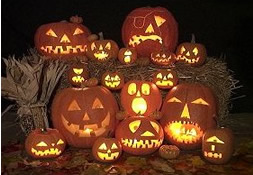 |
Halloween
jack-o-lanterns |
Bring
forth the raisins and the nuts
Tonight All-Hallows’ Spectre struts
Along the moonlit way.
John Kendrick Bangs (1852-1922)
The Pagan festival of Samhain (“summer’s end”) is the modern observance of the ancient Celtic New Year’s Eve. For the Celts, the year began on the 1 November, and the end of the year was a time when the barrier between worlds opened and it was possible to commune with the dead. Because of this the festival was believed to be a perfect time for divination; in Scotland, a child born on this day was said to be gifted with an dà shealladh, “the two sights”—commonly known as second sight, or clairvoyance.
Modern Pagans honour the Goddess in her crone aspect at Samhain, believing that it is this figure who opens the gates to the otherworld: as such, she rules the mysteries of death and regeneration, the occult sciences, healing, and wisdom. Fires were lit at dusk on the ancient sacred hilltops for the protection of people, their homes, and their livelihood; modern Pagans use fire in their magic circle rituals to conjure shields of protection and to illuminate the future.
The tradition of wearing costumes on Halloween and roaming from door to door demanding treats reflects the belief that offerings of food and drink should be left out at this time for the souls of the dead. The opening of the door to the otherworld also let loose fairies, witches, and demons, a belief that is reflected in the preference for disguises representing such figures. Other Halloween customs that hark back to the original Celtic harvest festival include bobbing for apples and carving root vegetables such as turnips and pumpkins.